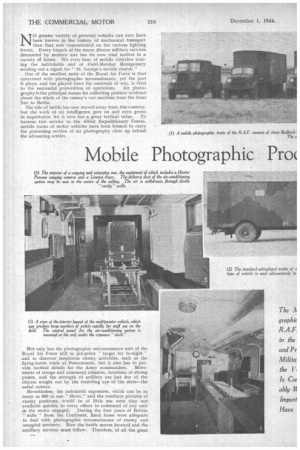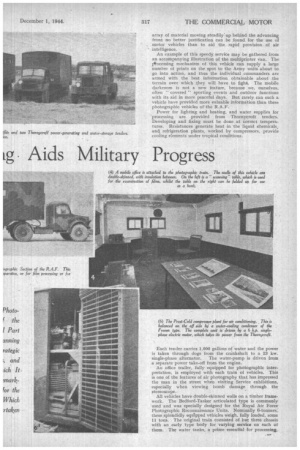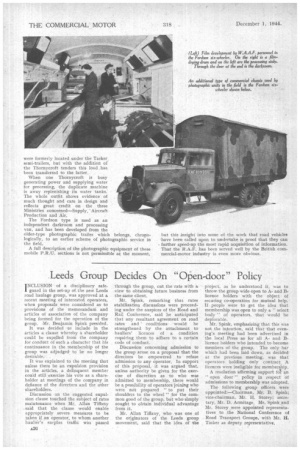Mobile Photographic Pro( Lg Aids Military Progress
Page 26

Page 27

Page 28

If you've noticed an error in this article please click here to report it so we can fix it.
N0 greater variety of powered vehicles can ever have been known in the history of mechanical transport than that now concentrated' on the various fighting fronts. Every branch of the many diverse military services demanded by modern war has its own road motors in a variety of forms. We even hear of mobile churches touring the battlefields and of Field-Marshal Montgomery sending out a signal for " St. George's mobile church."
One of the smallest units of the Royal Air Force is that concerned with photographic reconnaissance, yet the part it plays, and has played since the outbreak of war, is vital
to the successful prosectftion of operations. Air photographyls the principal means for collecting positive evidence about the whole of the enemy's war machine from the front line to Berlin.
The tide of battle has now moved away from this country, but the work of air intelligence goes on and even grows
in importance, for it now has a great tactical value. To harness this service to the Allied Expeditionary Forces, mobile trains of motor vehicles have been formed to carry the processing section of air photography close up behind the advancing armies.
Not only has the photographic reconnaissance unit of the • Royal Air Force still to pin-point "target for to-night" and to discover suspicious enemy activities, such as the flying-bomb trials at Peenemunde, but it also has to provide tactical details for the Army commanders. Movements of troops and armoured columns, locations of strong points, and the strength of artillery are but few of the objects sought out by the recording eye of the skies—the aerial camera.
Nevertheless, the automatic exposures, which can be as many as 500 in one '' shoot," and the resultant pictures of enemy positions, would be of little use were they not available quickly to every officer in command of any unit in the sector engaged. During the four years of British " exile " from the Continent, fixed bases were adequate to deal with photographic reconnaissance of enemy and • occupied territory. Now the battle moves forward and the ancillary services must follow. Therefore, of all the great array of material moving steadily' up behind the advancing front no better justification can be found, for the use of motor vehicles than to aid the rapid provision of air intelligence.
An example of this speedy service may be gathered from an accompanying illustration of -the multiprinter van. The iftocessing mechanism of this vehicle can supply a large number of prints on the spot to the Army units about to go into action, and thus the individual commanders are armed with the best information obtainable about the terrain over which they will have to fight. The mobile darkroom is not a new feature, because we, ourselves, often " covered " sporting events and outdoor functions with its aid in more peaceful days. But rarely can such a vehicle have provided more valuable information than these photographic vehicles of the R.A.F.
Power for lighting and heating, and water supplies for 'processing are provided from Thornytroft tenders. Developing and fixing must be done at correct temperatures. Resistances generate heat in the liquid chemicals, and refrigeration plants, worked by compressors, provide cooling elements under tropical conditions.
Each tender carries 1,000 gallons fwater and the power is taken through dogs from the crankshaft to a 23 kw. single-phase alternator. The water-pump is driven from a separate power take-off from the engine.
An office trailer, fully equipped for photographic interpretation, is employed with each train of vehicles. This is one of the features of air photography that has impressed the man in the street when visiting Service exhibitions, especially when viewing bomb damage through the stereoscope.
All vehicles have double-skinned walls on a timber framework. The Bedford-Tasker articulated type is commonly used and was specially designed for the Royal Air Force Photographic Reconnaissance Units. Nominally 6-tonners, these splendidly equipped vehicles Weigh, fully loaded, some 11 tons. The original train consisted of but three chassis with an early type body for varying service on each of them. The water tanks, a prime essential for processing, . were formerly located under the Tasker. semi-trailers, but with the additiOn of the Thornycroft tenders this load has been transferred to the latter.
When one Thornycroft is busy generating power and supplying water for processing, the duplicate machine is away replenishing its water tanks. The whole outfit shows evidence of much thought and care in design and reflects great credit on the three Ministries concerned—Supply, 'Aircraft Production and Air.
The Fordson type is used as an independent darkroom and processing van, and has been developed from the older-type photographic trailer which belongs, chronologically, to an earlier scheme of photographic service in the field.
A full description of the photographic equipment of these mobile P.R.U. sections is not permissible at the moment, but this insight into some of the work that road vehicles have been called upon to undertake is proof that they can further speed-up the most rapid acquisition of information. That the R.A.F. has been served well by the British commercial-motor industry is even more obvious.




















































